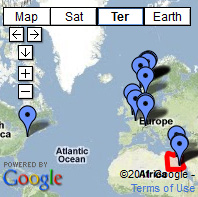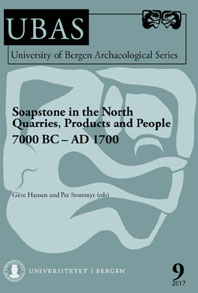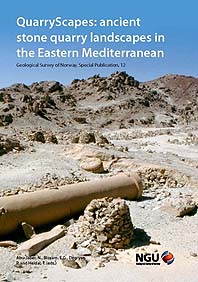
Deserves a place on the World Heritage List: The Gebel el-Silsila ancient sandstone quarries. Photo: Tom Heldal
Stone quarries were extremely important in ancient cultures, yet they are hardly represented on the World Heritage List. This might be due to misconceptions of the nature of such sites, as producers of raw materials “only”. But in reality many quarry sites were places of outstanding craftsmanship, engineering and organisation, not least in Ancient Egypt. In a paper written by James Harrell and myself some four years ago (and only now available), we propose establishing a serial World Heritage Site comprising selected Ancient Egyptian quarries. Few cultures relied on their quarries as much as Ancient Egypt; thus it would be natural that a comprehensive World Heritage Site addressing quarries should be set up just here along the Nile.
Back in 2010, before the revolution in Egypt, James Harrell and I were asked to contribute to an international workshop in Cairo, on the “Harmonization of African World Heritage Tentative Lists”. The workshop was organised by the Egyptian UNESCO Commission, in collaboration with The African World Heritage Fund. In 2013 the proceedings from the workshop were finalised and recently I received the collection of interesting papers and summaries from the editor, Professor and World Heritage Coordinator Samir Ghabbour at Cairo University.
The workshop addressed the imbalance in World Heritage Site types in Africa, and suggested ways to harmonise the tentative lists across the continent, to better represent the diverse natural and cultural heritage. Our contribution dealt with the famous ancient stone quarries in Egypt – a type of heritage that is not only strongly underrepresented on the list of African World Heritage, but also globally. In our paper we thus proposed working towards a serial nomination of the Egyptian quarries.
After the upheavals in Egypt, our four year-old paper might now seem a little outdated. Yet we believe that our basic message holds water: Quarries were extremely important in ancient cultures, not least in Egypt!, and thus they ought to be adequately represented on the World Heritage List. In our paper we note that:
“The Global Strategy of the UNESCO World Heritage Centre advocates a more balanced and representative World Heritage List in terms of both geographical distribution and types of sites and landscapes. Ancient stone quarries are one of the site types greatly under-represented on the current list. Many World Heritage Sites include ancient quarries within their boundaries, but in one case only has a site been selected due to its particular significance as an ancient quarry; the Spiennes flint quarry (or mine) in Belgium. In contrast, there is a dozen or so metal mining sites inscribed on the list. Furthermore, at the moment there seems to be only two quarry sites on the tentative list (the Yapease “money” quarry sites in the Pacific and the Carrara marble basin in Italy [and now the Hyllestad millstone quarries in Norway]). Given that ancient quarry sites are extremely numerous across the world and that such production sites contributed vastly to sustaining ancient cultures and shaping their (and our) landscapes, there is undoubtedly a call to increase the number of such sites on the list, to be inscribed due to their primary significance as quarries.”
And we continue:
“Few, if any, regions of the world exhibit such a wealth in ancient quarries for building, ornamental and utilitarian stone as Egypt. In a North-African context its stone quarry heritage is, of course, outstanding. Practically the whole Egyptian Nile Valley and several adjacent, remote desert areas comprise extensive series of continuous stone quarry landscapes, with the Pharaonic and Graeco-Roman sites as the largest and most visible. From this more than 3000 year long period there are considerably more than 200 large, individual quarries; they were in production over long time-spans and are often connected to neighbouring quarries as well as the sites where the stone was used.
Three Egyptian quarry sites are inscribed on the World Heritage List, not by virtue as quarries, but as part of larger sites: The New Kingdom Unfinished Obelisk in Aswan (“Nubian Monuments from Abu Simbel to Philae”), the Old Kingdom limestone quarries by the Giza pyramids and other pyramid sites (“Memphis and its Necropolis – the Pyramid Fields from Giza to Dahshur”) and the New Kingdom limestone quarry close to the Valley of the Kings on the west bank at Luxor (“Ancient Thebes with its Necropolis”). The Unfinished Obelisk is promoted as a quarry site and developed for visitors, but though millions visit the two other places their quarries are, understandably, entirely overshadowed by pyramids, tombs and temples. In addition, two ancient quarries figure rather prominently on the tentative Egyptian World Heritage list; Widan el-Faras (Old Kingdom basalt quarry) as part of Gebel Qatrani mixed natural/cultural site in the Northern Faiyum and the turquoise quarry (or mining) site as part of (or rather associated with) the Serabit el-Khadim temple in Sinai. Among the other 29(!) cultural and natural sites on the tentative list, very significant ancient quarries exist within at least six of them, but this is entirely coincidental and they are not (or hardly) mentioned in the proposals. These tentative sites are: “Dababiya” (a geological site), “Dahshour archaeological area”, “Desert wadis”, “Minia” (a generic term for various tomb-sites), “Necropolises of Middle Egypt from the Middle Empire to the Roman period” and “Mountain Chains” (various natural landscapes).”
What we propose is, basically, to review several of these tentative sites, as well as to contemplate on additional promotion of quarries sites. This is not to say that the other sites are unworthy of World Heritage status. Of course not. But quarries are present within several of the tentative sites – and they are strongly underrepresented on the World Heritage List.
Our paper includes a comprehensive list of potential candidates for a serial World Heritage nomination. We think that the well-known Unfinished Obelisk quarry at Aswan ought to become the spearhead of a nomination, also because it enjoys a fine management regime. Other sites that we mention includes selected sandstone, limestone and travertine quarries along the Nile (e.g. Gebel el-Silsila and Hatnub), several Roman sites in the Eastern Desert (e.g. Mons Porphyrites and Mons Claudianus), as well as sites in the Western Desert (e.g. Chephren’s Quarry and Widan el-Faras). Also, sites that produced gemstone and chert are on our list (e.g. Serabit el-Khadim, Sikait and Wadi el-Sheikh).
We conclude that:
“a serial nomination will have authority in terms of promotion, and thus it may aid in generating resources badly needed for further work on survey, excavation, value assessment, risk assessment, monitoring and – most importantly – conservation and management of ancient Egyptian quarry sites at large. Second, the authority of a serial nomination may aid the global promotion of ancient quarry sites and thus potentially encourage other countries to nominate – and conserve and manage – such often neglected and heavily threatened sites.”
Here’s the link to the full Proceedings of the workshop:
And here’s the link to a slightly edited version of our paper:
- Storemyr, P. & Harrell, J. (2013): The Ancient Stone Quarry Landscapes of Egypt: Proposal for a New Serial World Heritage Site. In Ghabbour, S. (ed.), Proceedings of the twin workshops on harmonization of African World Heritage Tentative Lists, 16-18 March and 29-30 May 2010. Organized by the Egyptian UNESCO Commission for Education, Science and Culture, in Collaboration with the African World Heritage Fund, South Africa, 281-329. View at academia.edu







It is difficult to find data on the Qurna limestone quarry on the West Bank of the Nile near Luxor, can you help me?
Johan Juurlink, japjoss@home.nl
Check out Nishimoto, S., Yoshimura, Y. and Kondo, J. ‘Hieratic Inscriptions from the Quarry at Qurna: an interim Report’, BMSAES 1 (2002), 14-25. http://www.thebritishmuseum.ac.uk/bmsaes/issue1/nishimoto.html (With several further references to the quarry).
Se also Klemm & Klemm’s book(s) on the quarries in Egypt.
Pingback: Notas e Agenda - Stone-ideas.com
Pingback: Noticias breves - Stone-ideas.com
Pingback: Appunti brevi - Stone-ideas.com
Pingback: Briefly noted - Stone-ideas.com
Pingback: Kurz notiert - Stone-ideas.com
Pingback: Around the Archaeology Blog-o-sphere Digest #9 | Doug's Archaeology